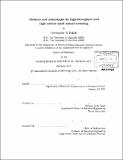| dc.contributor.advisor | Mehmet Fatih Yanik. | en_US |
| dc.contributor.author | Rohde, Christopher, 1979- | en_US |
| dc.contributor.other | Massachusetts Institute of Technology. Dept. of Electrical Engineering and Computer Science. | en_US |
| dc.date.accessioned | 2012-07-02T15:47:11Z | |
| dc.date.available | 2012-07-02T15:47:11Z | |
| dc.date.copyright | 2012 | en_US |
| dc.date.issued | 2012 | en_US |
| dc.identifier.uri | http://hdl.handle.net/1721.1/71486 | |
| dc.description | Thesis (Ph. D.)--Massachusetts Institute of Technology, Dept. of Electrical Engineering and Computer Science, 2012. | en_US |
| dc.description | Cataloged from PDF version of thesis. | en_US |
| dc.description | Includes bibliographical references (p. 157-170). | en_US |
| dc.description.abstract | High-throughput and high-content screening (HTS and HCS) of whole animals requires their immobilization for high-resolution imaging and manipulation. Here we present methods to enable HTS and HCS of the nematode Caenorhabditis elegans (C. elegans). First we present microfluidic technologies to rapidly isolate, immobilize, image and manipulate individual animals. These technologies include 1. a high-speed microfluidic sorter that can isolate and immobilize C. elegans in a well defined geometry for screening phenotypic features in physiologically active animals, 2. an integrated chip containing individually addressable screening-chamber devices for incubation and exposure of individual animals to biochemical compounds and high-resolution time-lapse imaging of multiple animals and 3. a design for delivery of compound libraries in standard multiwell plates to microfluidic devices and also for rapid dispensing of screened animals into multiwell plates. We then present an improved immobilization method that restrains animals with sufficient stability to perform femtosecond laser microsurgery and multiphoton imaging, without any apparent effects on animal health. We subsequently screen the contents of a small-molecule library for factors affecting neural regeneration following femtosecond laser microsurgery of C. elegans using these technologies. This screen identifies the kinase inhibitor staurosporine as a strong inhibitor of neural regeneration, and does so in a concentration and neuronal cell type-specific manner. Finally, we present a simple device for immobilizing C. elegans inside standard microtiter plates that is compatible with existing HTS systems. The device consists of an array of metal pins connected to individually-controlled thermoelectric coolers. 'We use this to perform femtosecond laser microsurgery on C. elegans in microtiter plates and to analyze the regeneration dynamics over time. This analysis shows that neurons tend regenerate in single short bursts that occur stochastically within the first two days post-surgery. | en_US |
| dc.description.statementofresponsibility | by Christopher B. Rohde. | en_US |
| dc.format.extent | 170 p. | en_US |
| dc.language.iso | eng | en_US |
| dc.publisher | Massachusetts Institute of Technology | en_US |
| dc.rights | M.I.T. theses are protected by
copyright. They may be viewed from this source for any purpose, but
reproduction or distribution in any format is prohibited without written
permission. See provided URL for inquiries about permission. | en_US |
| dc.rights.uri | http://dspace.mit.edu/handle/1721.1/7582 | en_US |
| dc.subject | Electrical Engineering and Computer Science. | en_US |
| dc.title | Methods and technologies for high-throughput and high-content small animal screening | en_US |
| dc.type | Thesis | en_US |
| dc.description.degree | Ph.D. | en_US |
| dc.contributor.department | Massachusetts Institute of Technology. Department of Electrical Engineering and Computer Science | |
| dc.identifier.oclc | 795576007 | en_US |
